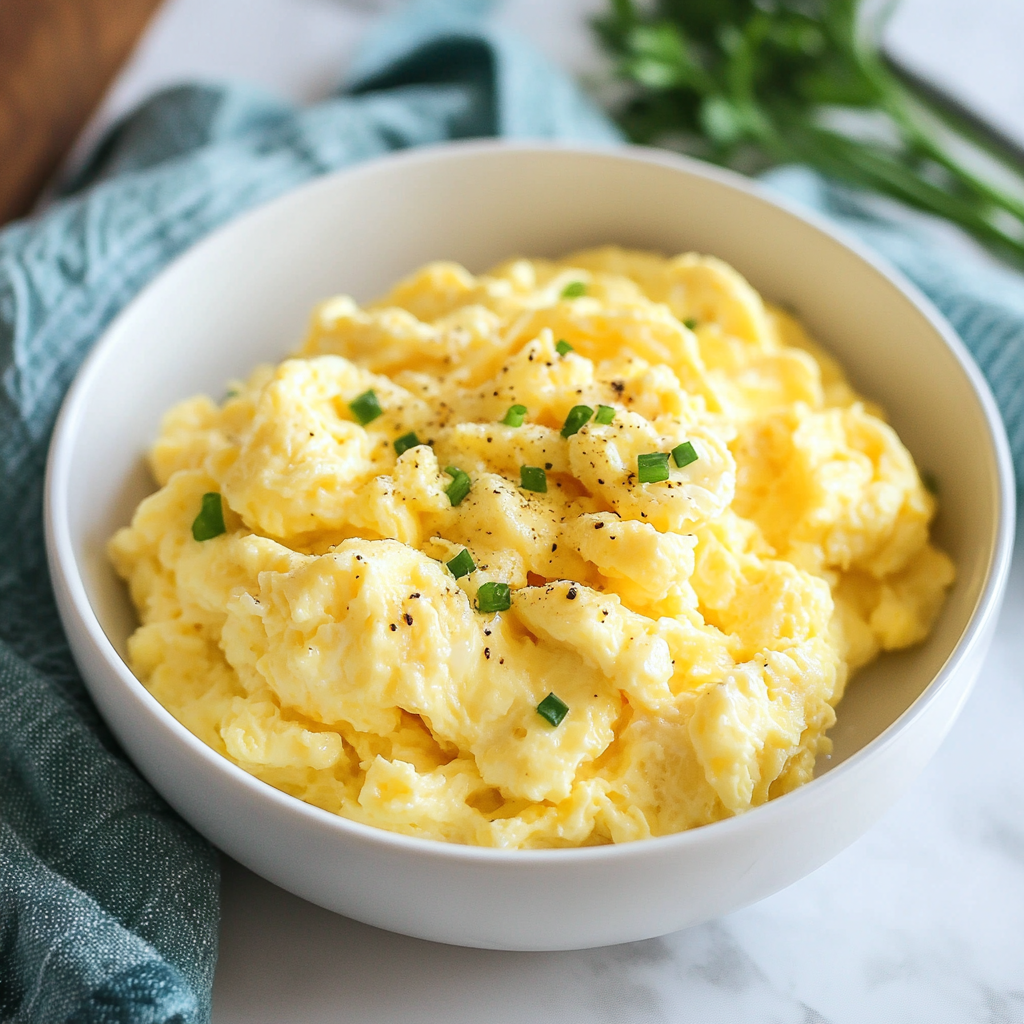Fluffy scrambled eggs are a simple yet decadent breakfast staple, prized for their soft, creamy texture and buttery richness. The secret lies in gentle cooking and the addition of milk or cream, which transforms ordinary eggs into a light, velvety delight that melts in your mouth.
This classic dish is endlessly versatile and can be enjoyed plain or enhanced with fresh herbs, cheese, or a side of toast. It’s the ultimate comfort food that’s quick to prepare yet feels indulgent, making it a favorite for both weekday mornings and leisurely brunches with friends or family.
Full Recipe
Ingredients:
-
4 large eggs
-
1/4 cup whole milk (or cream for extra richness)
-
1 tablespoon unsalted butter
-
Salt, to taste
-
Freshly ground black pepper, to taste
-
Optional: chopped fresh chives or parsley for garnish
Directions:
-
Crack the eggs into a bowl and add the milk. Whisk vigorously until the mixture is smooth and slightly frothy.
-
Heat a non-stick skillet over low to medium-low heat and add the butter, allowing it to melt gently without browning.
-
Pour the egg mixture into the pan and let it sit undisturbed for a few seconds until it just begins to set at the edges.
-
Using a silicone spatula, gently stir and fold the eggs from the edges toward the center, allowing curds to form slowly.
-
Continue to cook slowly, stirring occasionally but gently, until the eggs are mostly set but still creamy and slightly runny. Remove from heat immediately, as residual heat will finish cooking the eggs.
-
Season with salt and pepper to taste, garnish with fresh herbs if desired, and serve immediately for the best fluffy texture.
Prep Time: 5 minutes | Cooking Time: 5 minutes | Total Time: 10 minutes
Kcal: Approximately 180 kcal | Servings: 2 servings
The Art and Science of Making Fluffy Scrambled Eggs
Scrambled eggs may seem like a simple, everyday dish, but achieving that perfect fluffy texture requires a bit of knowledge and technique. Unlike ordinary scrambled eggs, which can sometimes turn out rubbery or dry, fluffy scrambled eggs have a delicate, creamy consistency that makes them truly stand out. The key is slow and gentle cooking combined with the right ingredients and mixing method.
The addition of milk or cream is one of the secrets behind this creamy texture. Milk adds moisture and softness to the eggs, creating a richer mouthfeel, while cream offers an even more indulgent, velvety finish. The gentle whisking of eggs with dairy also introduces a slight airiness to the mixture, which helps in achieving that cloud-like fluffiness when cooked.
Why Temperature Matters in Cooking Fluffy Eggs
Many home cooks tend to rush cooking scrambled eggs on high heat, resulting in tough, rubbery curds. The secret to fluffy eggs lies in low and slow heat. Cooking eggs gently over low or medium-low heat allows the proteins to coagulate gradually, forming soft curds rather than tightening up quickly. This slow coagulation process helps retain moisture and preserves the silky texture.
Using a non-stick skillet and a gentle folding motion while cooking ensures the eggs don’t stick to the pan or break into tiny dry pieces. A silicone spatula is ideal for softly stirring and folding the eggs, which helps maintain those beautiful large curds essential for a fluffy texture.
The Role of Butter in Fluffy Scrambled Eggs
Butter is more than just a flavor enhancer. When melted slowly in the pan before adding eggs, it creates a luscious base that enriches the eggs and prevents them from sticking. Butter also contributes to the creamy mouthfeel and adds a subtle nuttiness when cooked gently. If you prefer, you can use other fats such as olive oil or ghee, but butter is often preferred for its flavor and texture.
Adding butter at the start and allowing it to melt gently ensures that the eggs cook evenly and develop that delicate richness without browning or burning, which can alter the flavor and texture negatively.
How to Customize Your Fluffy Scrambled Eggs
While classic fluffy scrambled eggs are delicious on their own, they also serve as a perfect canvas for creativity. Fresh herbs like chives, parsley, or tarragon can be added just before serving to introduce a fresh burst of flavor and color. For a heartier breakfast, ingredients such as cheese (cheddar, goat cheese, or cream cheese), sautéed mushrooms, diced tomatoes, or cooked spinach can be gently folded into the eggs at the final stage.
For those seeking a savory twist, smoked salmon, crispy bacon, or even a dollop of sour cream pairs wonderfully with the creamy texture. If you prefer a vegan or dairy-free option, plant-based milk alternatives can replace dairy, and vegan butter substitutes can maintain richness.
Nutritional Benefits of Fluffy Scrambled Eggs
Eggs are a powerhouse of nutrition, rich in high-quality protein, essential vitamins such as B12 and D, and minerals like selenium and choline. Incorporating eggs into your diet supports muscle health, brain function, and eye health, among many other benefits. The addition of milk or cream adds calcium and vitamin A, contributing to a balanced breakfast.
Because scrambled eggs can be paired with a variety of wholesome ingredients, they can fit many dietary preferences and needs, from low-carb to keto-friendly or even high-protein meal plans.
Common Mistakes to Avoid When Making Fluffy Scrambled Eggs
One of the most frequent errors is cooking eggs at too high a temperature. High heat causes rapid protein coagulation, which leads to dry, tough eggs. Another mistake is over-stirring or constantly stirring eggs; this breaks the curds into tiny pieces and prevents fluffiness. Instead, gently fold the eggs occasionally to allow large curds to form.
Using cold eggs straight from the fridge can sometimes hinder smooth cooking. Letting eggs come to room temperature before cooking helps them cook more evenly. Additionally, seasoning eggs too early can cause them to become watery; it’s better to add salt and pepper toward the end or just before serving.
The Cultural and Comfort Food Aspect of Scrambled Eggs
Scrambled eggs are beloved worldwide, enjoyed in many variations across cultures. From the simple buttered scrambled eggs in France to spiced versions in the Middle East and fluffy, creamy styles in the US and UK, this dish embodies comfort and nourishment. It’s often one of the first dishes children learn to cook and remains a staple in home kitchens and diners alike.
The familiarity and simplicity of scrambled eggs provide a sense of comfort, making them a go-to meal when you want something quick, satisfying, and soothing. They pair wonderfully with toast, fresh fruit, and coffee, making them a cornerstone of traditional breakfast culture.
Tips for Serving and Pairing Fluffy Scrambled Eggs
Fluffy scrambled eggs shine best when served immediately while still warm and creamy. Pair them with toasted sourdough bread or buttery croissants for a classic breakfast. Freshly sliced avocado or a side of roasted tomatoes complements the richness perfectly. For a balanced meal, add sautéed greens or a small salad on the side.
These eggs also make an excellent filling for breakfast sandwiches or wraps and can be a topping for savory bowls with grains and vegetables. Their versatility allows them to be enjoyed anytime – breakfast, brunch, or even a light dinner.
Conclusion
Fluffy scrambled eggs may appear simple, but mastering the technique turns this everyday dish into a luxurious and comforting experience. With the right approach—using gentle heat, adding dairy, and careful folding—you can achieve a soft, creamy texture that elevates your breakfast to a new level.
This dish is incredibly versatile, nutritious, and quick to prepare, making it a timeless favorite in kitchens around the world. Whether enjoyed plain or enhanced with your favorite herbs and add-ins, fluffy scrambled eggs are sure to become a staple for anyone seeking a delicious, satisfying start to the day.






